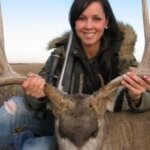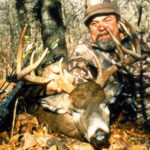John’s Note: Most sportsmen think they must manipulate habitat and provide more food for more deer to manage the wildlife on their lands. But you can have inexpensive deer herd management by applying the tactics of Dr. Grant Woods of Reedsville, Missouri, a well-known wildlife biologist, and other avid outdoorsmen who love developing their lands and deerherds.
 Many outdoorsmen next suggest you spend $20-$30 on buying bullets, and then harvest as many mature does as you legally can on the land you hunt. Your wildlife consultant and/or your state department of conservation can help you determine how many does to take off the property where you hunt to have fewer deer on the land than the land can support. You want to remove as many does as possible to ensure that the remaining bucks have plenty of food to eat all year long. In many sections of the country, especially in the East, many lands have an overabundance of deer. Since most hunters prefer to bag bucks, then removing the does will guarantee that the bucks have more food to eat, grow to the older-age classes and reach their potential in antler development and body weights.
Many outdoorsmen next suggest you spend $20-$30 on buying bullets, and then harvest as many mature does as you legally can on the land you hunt. Your wildlife consultant and/or your state department of conservation can help you determine how many does to take off the property where you hunt to have fewer deer on the land than the land can support. You want to remove as many does as possible to ensure that the remaining bucks have plenty of food to eat all year long. In many sections of the country, especially in the East, many lands have an overabundance of deer. Since most hunters prefer to bag bucks, then removing the does will guarantee that the bucks have more food to eat, grow to the older-age classes and reach their potential in antler development and body weights.
Why Set-Up No-Hunt Deer Zones?
To grow more big bucks on the property where you hunt, deer need three elements: food, sanctuary and age. This inexpensive (about $100) deer-management program for 1,000 acres primarily has concerned itself with producing more food and reducing the number of deer eating that food. However, if you don’t provide sanctuary for your land’s bucks, as they grow older, they’ll leave the property.
 Many avid land developers for the best wild-game production consider sanctuary an important component of any deer-management program that doesn’t cost money. In many places, simply providing sanctuary, especially during deer season, will guarantee that you have more big bucks on your property than other hunting clubs do. You don’t have to be a rocket scientist to realize that the more sanctuary you provide for deer, the more older-age-class bucks your land will attract. However, a good rule of thumb is to put 10 percent of the land you hunt into sanctuary. For instance, if you have 100 acres of land to hunt, then consider placing 10 acres in sanctuary as close to the center of your property as possible. Then there’s less of a chance that the deer will migrate off your land onto your neighbor’s property during daylight hours.
Many avid land developers for the best wild-game production consider sanctuary an important component of any deer-management program that doesn’t cost money. In many places, simply providing sanctuary, especially during deer season, will guarantee that you have more big bucks on your property than other hunting clubs do. You don’t have to be a rocket scientist to realize that the more sanctuary you provide for deer, the more older-age-class bucks your land will attract. However, a good rule of thumb is to put 10 percent of the land you hunt into sanctuary. For instance, if you have 100 acres of land to hunt, then consider placing 10 acres in sanctuary as close to the center of your property as possible. Then there’s less of a chance that the deer will migrate off your land onto your neighbor’s property during daylight hours.
 Also consider having some type of thick-cover corridor that links one sanctuary to another sanctuary. Bucks like to move around, especially during the rut, but they don’t want to expose themselves to openings. By providing these thick-cover corridors from one sanctuary to another, bucks will use these thick-cover areas to check for estrous does during the rut. You can hunt the bucks in these thick-cover corridors between the sanctuaries and not violate the safe havens that the sanctuaries provide. Planning where your club won’t allow anyone to hunt deer also enables the members of your hunting lease to identify the areas where they can hunt and to drastically increase their odds for taking older-age class bucks every season.
Also consider having some type of thick-cover corridor that links one sanctuary to another sanctuary. Bucks like to move around, especially during the rut, but they don’t want to expose themselves to openings. By providing these thick-cover corridors from one sanctuary to another, bucks will use these thick-cover areas to check for estrous does during the rut. You can hunt the bucks in these thick-cover corridors between the sanctuaries and not violate the safe havens that the sanctuaries provide. Planning where your club won’t allow anyone to hunt deer also enables the members of your hunting lease to identify the areas where they can hunt and to drastically increase their odds for taking older-age class bucks every season.
You’ll learn more hunting information and tips from hunters in John E. Phillips’ Kindle, CreateSpace and Audible books. Go to https://johninthewild.com/books/#deer to purchase and download to your Kindle, and/or download a Kindle app for your iPad, SmartPhone or computer. You also can go to Nook Books at www.barnesandnoble.com to buy.
Also you can download free books by going to https://johninthewild.com/free-books.










